Page 148 of 212
144
8. Reinstall all the wheel nuts fingertight.
Reinstall the wheel nuts and tighten them
as much as you can by hand. Press back
on the tire back and see if you can tighten
them more.9. Lower the vehicle completely and
tighten the wheel nuts.
To lower the vehicle, turn the jack handle counterclockwise. Use only the wheel nut wrench to tighten the nuts. Do not use other tools or any
additional leverage other than your
hands, such as a hammer, pipe or your
foot. M ake sure the wrench is securely en-
gaged over the nut.
Tighten each nut a little a time in the order
shown. Repeat the process until all the
nuts are tight.10. Reinstall the wheel ornament.
Put the wheel ornament into position and
then tap it firmly with the side or heel ofyour hand to snap it into place.
Take due care in handling the
ornament to avoid unexpected
personal injury. CAUTION
!
ÐLowering your vehicle ÐReinstalling wheel ornament
ÐReinstalling wheel nuts
Page 149 of 212
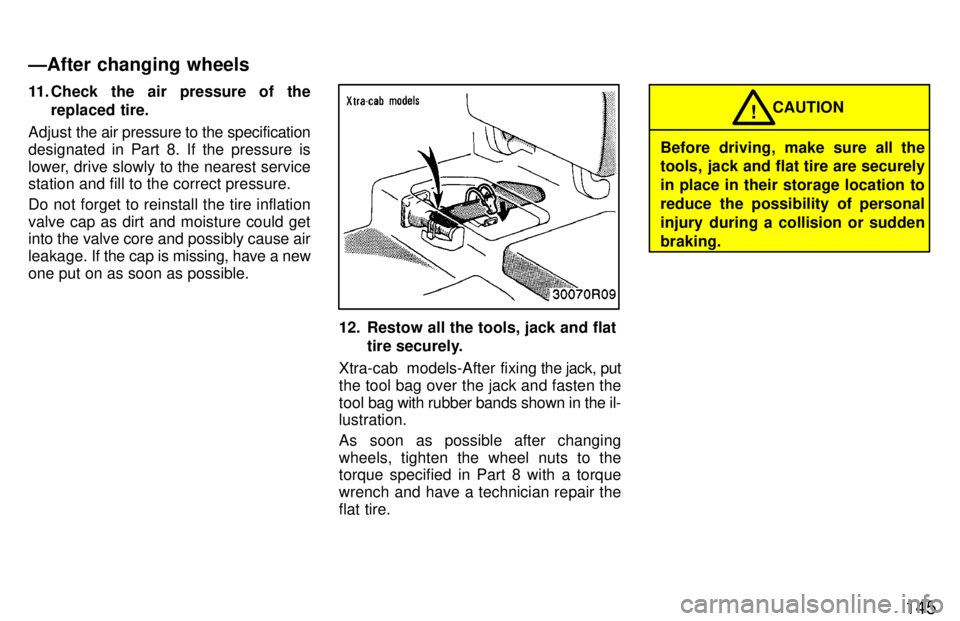
145
11. Check the air pressure of the
replaced tire.
Adjust the air pressure to the specification
designated in Part 8. If the pressure is
lower, drive slowly to the nearest service station and fill to the correct pressure.
Do not forget to reinstall the tire inflation valve cap as dirt and moisture could get into the valve core and possibly cause air
leakage. If the cap is missing, have a new
one put on as soon as possible.
12. Restow all the tools, jack and flat
tire securely.
Xtra-cab models-After fixing the jack, put
the tool bag over the jack and fasten the tool bag with rubber bands shown in the il-
lustration.
As soon as possible after changing
wheels, tighten the wheel nuts to the torque specified in Part 8 with a torque
wrench and have a technician repair the
flat tire.
Before driving, make sure all the
tools, jack and flat tire are securely in place in their storage location to
reduce the possibility of personal
injury during a collision or suddenbraking. CAUTION
!
ÐAfter changing wheels
Page 150 of 212

146
If towing is necessary, we recommend
you to have it done by your Toyota
dealer or a commercial tow truck ser-
vice. In consultation with them, have
your vehicle towed using either (a) or (b).
Only when you cannot receive a tow-
ing service from a Toyota dealer or
commercial tow truck service, tow
your vehicle carefully in accordance
with the instructions given in
ÐEmergency towingº in this part. Proper equipment will help ensure that your vehicle is not damaged while being
towed. Commercial operators are gener-
ally aware of the state/provincial and local
laws pertaining to towing.
Your vehicle can be damaged if it is towed
incorrectly. Although most operators know the correct procedure, it is possible
to make a mistake. To avoid damage to your vehicle, make sure the following few
precautions are observed. If necessary,
show this page to the tow truck driver.
TOWING PRECAUTIONS: Use a safety chain system for all towing,
and abide by the state/provincial and local
laws. The wheels and axle on the ground
must be in good condition. If they are
damaged, use a towing dolly.
If your vehicle needs to be towedÐ
Page 151 of 212
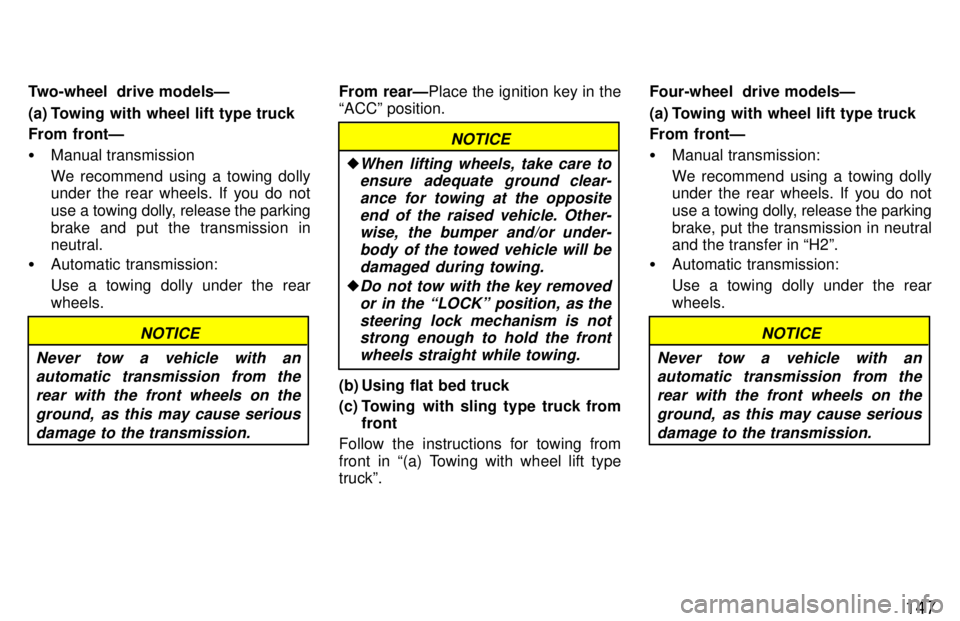
147
Two-wheel drive modelsÐ
(a) Towing with wheel lift type truck From frontÐ �
Manual transmission
We recommend using a towing dolly under the rear wheels. If you do not
use a towing dolly, release the parkingbrake and put the transmission in neutral.
� Automatic transmission: Use a towing dolly under the rear wheels.
NOTICE
Never tow a vehicle with an automatic transmission from the
rear with the front wheels on theground, as this may cause serious damage to the transmission.
From rearÐ Place the ignition key in the
ACCº position.
NOTICE
�When lifting wheels, take care to
ensure adequate ground clear-
ance for towing at the oppositeend of the raised vehicle. Other-wise, the bumper and/or under-
body of the towed vehicle will be damaged during towing.
�Do not tow with the key removedor in the LOCKº position, as thesteering lock mechanism is notstrong enough to hold the front
wheels straight while towing.
(b) Using flat bed truck
(c) Towing with sling type truck from front
Follow the instructions for towing from
front in (a) Towing with wheel lift type truckº. Four-wheel drive modelsÐ
(a) Towing with wheel lift type truck From frontÐ �
Manual transmission:
We recommend using a towing dolly under the rear wheels. If you do not
use a towing dolly, release the parking
brake, put the transmission in neutral
and the transfer in H2º.
� Automatic transmission: Use a towing dolly under the rear wheels.
NOTICE
Never tow a vehicle with an automatic transmission from the
rear with the front wheels on theground, as this may cause serious damage to the transmission.
Page 152 of 212
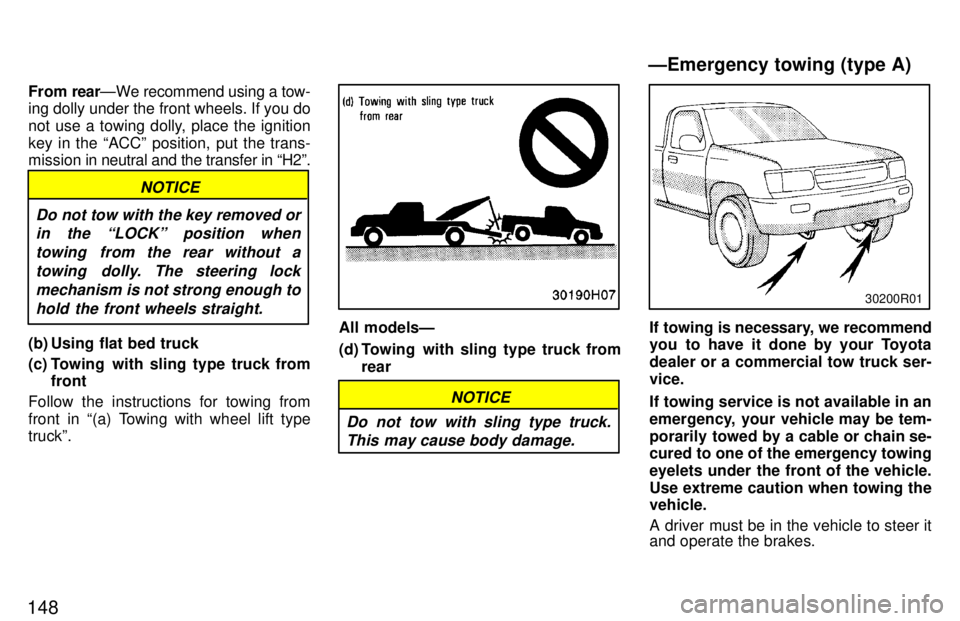
148From
rearÐWe recommend using a tow-
ing dolly under the front wheels. If you do
not use a towing dolly, place the ignitionkey in the ACCº position, put the trans-
mission in neutral and the transfer in H2º.
NOTICE
Do not tow with the key removed or in the LOCKº position when
towing from the rear without a towing dolly. The steering lockmechanism is not strong enough to hold the front wheels straight.
(b) Using flat bed truck
(c) Towing with sling type truck from front
Follow the instructions for towing from
front in (a) Towing with wheel lift type truckº.
All modelsÐ
(d) Towing with sling type truck from rear
NOTICE
Do not tow with sling type truck. This may cause body damage.
30200R01
If towing is necessary, we recommend
you to have it done by your Toyota
dealer or a commercial tow truck ser-vice.
If towing service is not available in an
emergency, your vehicle may be tem-
porarily towed by a cable or chain se-
cured to one of the emergency towing
eyelets under the front of the vehicle.
Use extreme caution when towing the vehicle.
A driver must be in the vehicle to steer it and operate the brakes.
ÐEmergency towing (type A)
Page 153 of 212
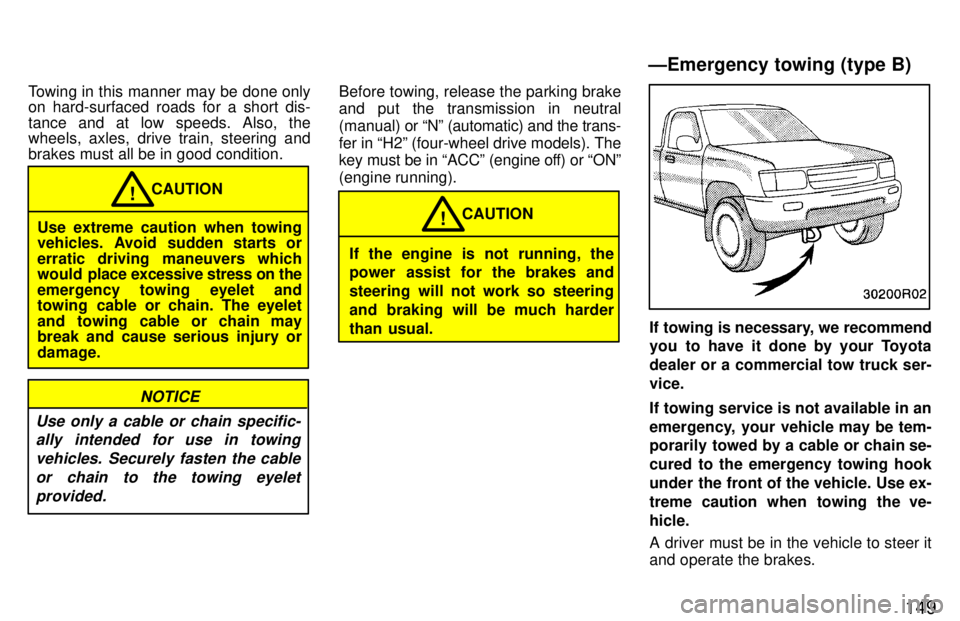
149
Towing in this manner may be done only
on hard-surfaced roads for a short dis-
tance and at low speeds. Also, the
wheels, axles, drive train, steering and brakes must all be in good condition.
CAUTION!
Use extreme caution when towing
vehicles. Avoid sudden starts or
erratic driving maneuvers which
would place excessive stress on the
emergency towing eyelet and
towing cable or chain. The eyelet
and towing cable or chain may break and cause serious injury or damage.
NOTICE
Use only a cable or chain specific- ally intended for use in towing
vehicles. Securely fasten the cableor chain to the towing eyelet provided.
Before towing, release the parking brake
and put the transmission in neutral
(manual) or Nº (automatic) and the trans-
fer in H2º (four-wheel drive models). The
key must be in ACCº (engine off) or ONº
(engine running).
CAUTION!
If the engine is not running, the
power assist for the brakes and
steering will not work so steering
and braking will be much harder
than usual.
If towing is necessary, we recommend
you to have it done by your Toyota
dealer or a commercial tow truck ser-vice.
If towing service is not available in an
emergency, your vehicle may be tem-
porarily towed by a cable or chain se-
cured to the emergency towing hook
under the front of the vehicle. Use ex-
treme caution when towing the ve-hicle.
A driver must be in the vehicle to steer it and operate the brakes.
ÐEmergency towing (type B)
Page 154 of 212
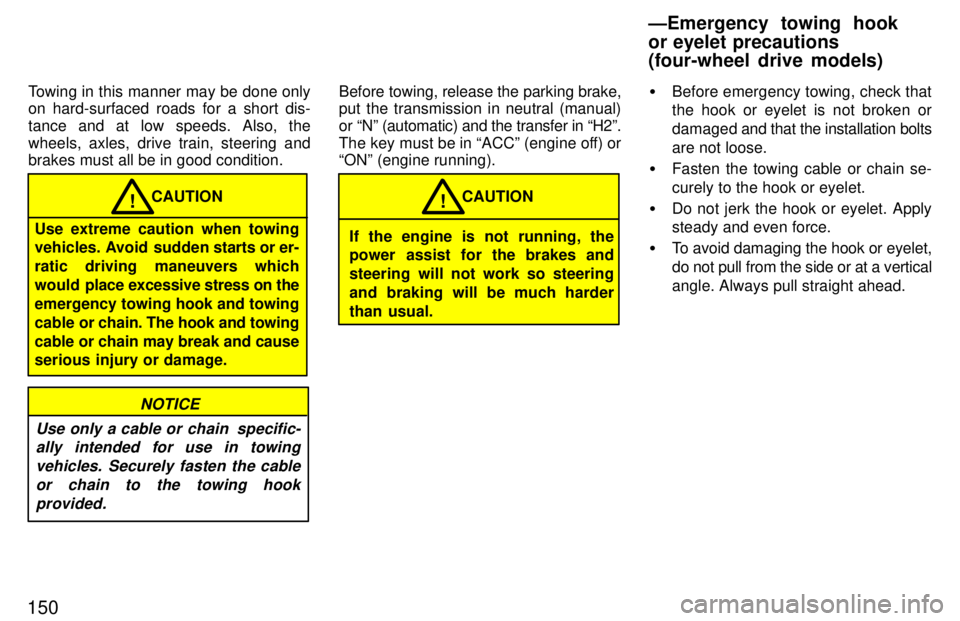
150Towing in this manner may be done only
on hard-surfaced roads for a short dis-
tance and at low speeds. Also, the
wheels, axles, drive train, steering and brakes must all be in good condition.
CAUTION!
Use extreme caution when towing
vehicles. Avoid sudden starts or er- ratic driving maneuvers which
would place excessive stress on the
emergency towing hook and towing
cable or chain. The hook and towing
cable or chain may break and cause
serious injury or damage.
NOTICE
Use only a cable or chain specific- ally intended for use in towing
vehicles. Securely fasten the cableor chain to the towing hook provided.
Before towing, release the parking brake, put the transmission in neutral (manual)
or Nº (automatic) and the transfer in H2º.
The key must be in ACCº (engine off) or ONº (engine running).
CAUTION!
If the engine is not running, the
power assist for the brakes and
steering will not work so steering
and braking will be much harder
than usual. �
Before emergency towing, check that the hook or eyelet is not broken or
damaged and that the installation bolts
are not loose.
� Fasten the towing cable or chain se-curely to the hook or eyelet.
� Do not jerk the hook or eyelet. Apply
steady and even force.
� To avoid damaging the hook or eyelet, do not pull from the side or at a vertical
angle. Always pull straight ahead.
ÐEmergency towing hookor eyelet precautions (four-wheel drive models)
Page 155 of 212
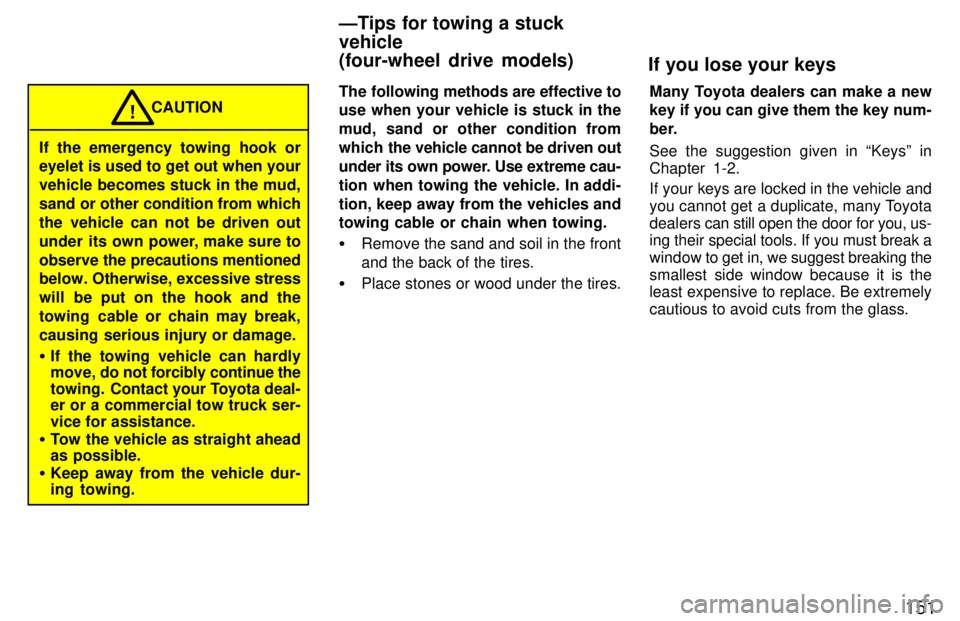
151
If the emergency towing hook or
eyelet is used to get out when your
vehicle becomes stuck in the mud,
sand or other condition from which
the vehicle can not be driven out
under its own power, make sure to
observe the precautions mentioned
below. Otherwise, excessive stress
will be put on the hook and the
towing cable or chain may break,
causing serious injury or damage. �If the towing vehicle can hardly
move, do not forcibly continue the
towing. Contact your Toyota deal-
er or a commercial tow truck ser- vice for assistance.
� Tow the vehicle as straight ahead as possible.
� Keep away from the vehicle dur-
ing towing. CAUTION
!
The following methods are effective to
use when your vehicle is stuck in the
mud, sand or other condition from
which
the vehicle cannot be driven out
under its own power. Use extreme cau-
tion when towing the vehicle. In addi-tion, keep away from the vehicles and towing cable or chain when towing. � Remove the sand and soil in the front and the back of the tires.
� Place stones or wood under the tires. Many Toyota dealers can make a new
key if you can give them the key num-
ber. See the suggestion given in Keysº in Chapter 1-2.
If your keys are locked in the vehicle and
you cannot get a duplicate, many Toyota
dealers
can still open the door for you, us-
ing their special tools. If you must break a
window to get in, we suggest breaking the
smallest side window because it is the least expensive to replace. Be extremely cautious to avoid cuts from the glass.
ÐTips for towing a stuck vehicle (four-wheel drive models)
If you lose your keys